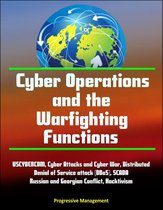Cyberterrorism After Stuxnet - Terrorist Cyberattacks, Distributed Denial of Service (DDoS), Motives, Critical U.S. Infrastructure Vulnerabilities, al-Qaeda Computer Capability, PC Attacks Ebook Tooltip Ebooks kunnen worden gelezen op uw computer en op daarvoor geschikte e-readers.
Afbeeldingen
Artikel vergelijken
- Engels
- E-book
- 9781310219450
- 11 januari 2015
- Epub zonder kopieerbeveiliging (DRM)
Samenvatting
Public government statements have cited cyber-attacks by terrorists as a major concern for national security. To date, no large-scale cyber-terrorist attack has been observed, but terrorists are known to be using the Internet for various routine purposes. The discovery of Stuxnet in 2010 was a milestone in the arena of cybersecurity because, although a malware attack on industrial control systems was long believed to be theoretically possible, it was different to see malware used in reality to cause real physical damage. Stuxnet demonstrated that a sufficiently determined adversary with sufficient resources might be able to damage U.S. critical infrastructure physically through a cyber attack. Did Stuxnet change the threat of cyber-terrorism?
This monograph examines cyberterrorism before and after Stuxnet by addressing three questions: 1) Motive—Are terrorists interested in launching cyber-attacks against U.S. critical infrastructures? 2) Means —Are terrorists building capabilities and skills for cyberattacks? and, 3) Opportunity—How vulnerable are U.S. critical infrastructures? Answers to these questions give a characterization of the post-Stuxnet cyberterrorism threat. The next question is why a major cyber-terrorist attack has not happened yet; this is explained from a cost-benefit perspective. Although cyberterrorism may not be an imminent threat, there are reasons to be concerned about the long-term threat and inevitability of cyberattacks. It is important to assess frequently the threat landscape and current government policies for enhancing the protection of national infrastructures.
Terrorists are known to use the Internet for communications, planning, recruitment, propaganda, and reconnaissance. They have shown interest in carrying out cyberattacks on U.S. critical infrastructures, although no such serious attacks are known publicly to have occurred. The discovery of the Stuxnet malware in July 2010, and its analysis over the next several months, was widely believed to have been a landmark event in cybersecurity, because it showed that cyberattacks against industrial control systems, hypothesized for a long time, are actually possible. After Stuxnet, there were public concerns that terrorists might be encouraged to acquire capabilities for similar cyberattacks.
Productspecificaties
Inhoud
- Taal
- en
- Bindwijze
- E-book
- Oorspronkelijke releasedatum
- 11 januari 2015
- Ebook Formaat
- Epub zonder kopieerbeveiliging (DRM)
Betrokkenen
- Hoofdauteur
- Progressive Management
- Hoofduitgeverij
- Smashwords Edition
Lees mogelijkheden
- Lees dit ebook op
- Android (smartphone en tablet) | Kobo e-reader | Desktop (Mac en Windows) | iOS (smartphone en tablet) | Windows (smartphone en tablet)
Overige kenmerken
- Studieboek
- Nee
EAN
- EAN
- 9781310219450
Je vindt dit artikel in
- Categorieën
- Taal
- Engels
- Boek, ebook of luisterboek?
- Ebook
- Beschikbaarheid
- Leverbaar
- Beschikbaar in Kobo Plus
- Beschikbaar in Kobo Plus
Kies gewenste uitvoering
Prijsinformatie en bestellen
De prijs van dit product is 9 euro en 15 cent.- E-book is direct beschikbaar na aankoop
- E-books lezen is voordelig
- Dag en nacht klantenservice
- Veilig betalen
Rapporteer dit artikel
Je wilt melding doen van illegale inhoud over dit artikel:
- Ik wil melding doen als klant
- Ik wil melding doen als autoriteit of trusted flagger
- Ik wil melding doen als partner
- Ik wil melding doen als merkhouder
Geen klant, autoriteit, trusted flagger, merkhouder of partner? Gebruik dan onderstaande link om melding te doen.








